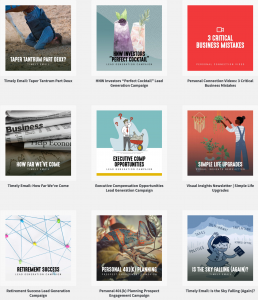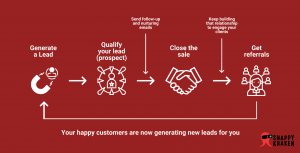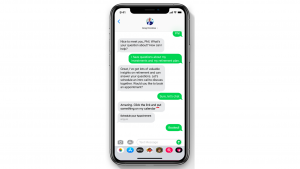How to Prioritize Your Marketing Plans
Before reading this guide, take our quick 5-minute quiz to get your Marketing Opportunity Score and specific marketing tips that will boost your revenue.
Most advisers think that to get results out of their marketing, they need to do it all. Organizing events, setting up lead generation campaigns, emailing all of their clients and leads every day, spending countless hours on social media, creating videos, setting up ads—the list goes on.
Spending too much time (and money) on marketing means the average adviser ends up spending a whopping $3,119 to get one single client—$519 in hard dollars and $2,600 in time costs.
We’re gonna let you in on a secret: you don’t need to dot every I and cross every T to see a return on your marketing efforts.

The most valuable marketing tactics can be automated, letting you spend your precious time on what’s most important: your clients. Here’s how to prioritize your marketing efforts. All of the tactics in this list can be done with the help of automation.
Here’s how to separate the most important marketing efforts from the ones that can wait. All of the tactics in this list can be done in less than a few hours a month with the help of automation.
4 Must-Do Marketing Tactics You Should Do Right Now
These four moves will help make sure your marketing runs itself, and you never run out of potential new clients. Pair them with our Cold to Gold Framework to make your marketing even more effective.
1. Collect and Segment Client and Prospect Emails
Email is the single most important business driver for every financial adviser. Email drives 71.3% of all traffic and has an average click-through rate (CTR) of 6.82%. That’s over 11.5 times higher than Facebook’s results.
You need to get your prospects’ email addresses and make sure that you have all of your clients’ information on file so that you can build credibility, nurture your relationships and increase engagement:
- To collect emails from your prospects, present them with gated content—ebooks, checklists, videos, and other high-value offers that they can only get access to if they provide their name and email address.
- To collect emails from your clients, reach out to all of them via phone and simply ask.
After you’ve collected all the important email addresses, put them in your customer relationship management (CRM) system. Segment and tag them based on financial needs, interests, and how far they are to closing, so you can deliver the right emails to the right people. Hint: most modern CRMs let you tag entries automatically!
2. Set Up Different Types of Emails and Email Sequences
Your target audience is made up of different personas—from young adults who are looking for college-planning services to people who are almost at the retirement stage. You need to create different emails and email sequences that are relevant to all of those people in your target market to better engage with them.

Here are the must-have email sequences that you need to create to send your leads and clients engaging personalized content:
- Lead nurturing email sequence: This is a series of educational emails that are related to whatever gated content your lead downloaded. Ninety-six percent of website visitors (i.e., your leads) aren’t ready to buy. A nurturing sequence will increase your sales-ready leads by 50% while lowering acquisition costs by 33%.
- Events-based: Current events, like political and economic shifts, can cause leads and clients to worry about their finances. Send them quarterly economic updates and reassuring messages that address their concerns to keep them in the loop and establish yourself as a reliable resource.
- Lifestyle and personal finance: Send your clients financial adjacent emails that talk about hobbies, interests, and lifestyles that link back to finance. Our top three email subject lines in 2020 were all financial-adjacent—“Some thoughts on racism and inequality,” “Can I ask your advice?” and “Happy Holidays!”
- Onboarding email sequence. Send new clients onboarding emails so that they don’t forget about you or feel like you’ve dropped the ball. Be proactive, ask them how you can help, and build a relationship early on.
3. Set Up Profiles, Create Organic Posts, and Run Ads on Facebook and LinkedIn
After emails, Facebook and LinkedIn are the two next best-performing channels in terms of engagement and conversions. Paid and organic Facebook posts account for 24.1% of traffic and have a combined conversion rate of 7.1%, while organic LinkedIn posts drive 4.2% of traffic and have a conversion rate of 5.6%.
Set up Facebook Business and LinkedIn pages for yourself or your company and create and publish organic posts to those accounts at least once a week. When creating content, remember that each platform has a different audience—82.6% of Facebook users are ages 18 to 54, which gives you a more varied audience, while LinkedIn is better for targeting pre-retirees and wealth accumulators.
You can also run different types of ads and boost posts to drive more traffic to your business pages and generate more followers. To get even more out of social media, make sure that all your paid ads and some of your organic posts link to landing pages with gated content so that you can collect emails from prospects.
4. Build a Referral Funnel to Create Viral Loops
Referrals, or word-of-mouth recommendations, are among the most cost-effective ways for advisors to find new clients. Referrals usually start the client journey with a higher level of trust because they learned about you from a trusted source (a friend or family member). Happy clients will help refer their friends, who then become happy clients and generate even more leads for you.

3 Other “Nice to Have” Marketing Tactics That You Should Do If You Have the Time
When you’re done setting up the essential marketing tactics, you can do three more things to increase revenue and lead-to-client conversions.
1. Experiment with Text Messaging
Sixty-three percent of clients prefer to receive text messages over other forms of communication, and text messages have a read rate of 98%. Yet, not a lot of companies are using text messaging in their marketing, meaning the opportunity to reach more clients is wide open.

If you have the time and money to invest, look into text messaging as a more engaging way to reach prospects and nurture clients. Send your prospects and clients messages asking how they’re doing, what problems you can solve for them and links to schedule an appointment.
With our Leads Never Cold automated text messaging system, you can create compliant text campaigns that guarantee real conversations.
2. Create and Distribute Video Content
Using videos in your emails and ads increases the engagement rate significantly. Video content is a more engaging medium than images or text—emails that linked to video landing pages have a 46.04% engagement rate. That’s 6.51% higher than all other emails.
To start creating and distributing video content, you need to first choose a reliable hosting service—we recommend YouTube, Vimeo, or Wistia. Then, create your video; we’ve got scripts that you can personalize and use in your video updates. We recommended sending video messages monthly and redirecting prospects and clients to a page where they can book a call with you.
3. Organize Events
Events are a great way to educate and engage with your clients and prospects and get referrals. If you’re not sure whether to host your next event online of offline, we can help you find the answer.
2 Marketing Tactics That You Should Only Do If Beneficial
Different marketing tactics work better for some than others. These two efforts have helped businesses grow exponentially but didn’t work quite as well for others—it’s up to you to determine if they are worth trying.
1. Market on Twitter
Twitter is great for engaging clients and following other professionals, but it’s not really designed for connecting with prospects and can become a black hole for your precious time. If you think Twitter is worth it, set up an account, allot 15 minutes each day to interact with other users on the platform and create and publish at least one post a week.
2. Buy Leads (with caution!)
To most marketers, buying leads or email lists is taboo: they’re expensive and ineffective because most of your emails will go to spam. We have a strict policy against uploading “purchased lists” at Snappy Kraken to protect our members.
But… here’s where the nuance comes in.
You can buy lead contact info providing that (a) the lead opted-in to receiving communication and (b) would be primed or expecting to hear from you.
Here’s an example that matches that criteria:
A company like SmartAsset has a program called SmartAdvisor. They go out, and they survey investors who are looking for financial advice. From there, they have a team that contacts these people, get additional contact info, and finds out what their needs are.
Then, they take the list of investors and find advisers within their network who match the criteria and needs of the investor.
SmartAdvisor sends the lead info to the adviser “matches” (up to 3 as of this writing), who can reach out to start a conversation.
Beware: buying leads is approached differently depending on the company.
Make sure you’re not just buying a random list of email addresses that some company cobbled together. Emailing random strangers like this is a surefire way to get SPAM reports and possibly get your domain blocked. This is serious.
Another company that vets investor info is WiserAdvisor. As with any tool or service, do your research and get clear on the vetting process, so you know you’re helping your chances at marketing success.
Build Up Your Marketing Efforts One Step at a Time—We Can Help!
Remember: no marketing strategy brings instant results. If you don’t see an immediate uptick in lead generation and client acquisition, don’t switch gears and go back to trying a million tactics. Just keep moving forward, and you’ll start to see results eventually.
The key to a good marketing strategy is a clear focus on your ultimate goal and the ability to create viral loops like our Cold to Gold Framework.
Book A Demo Today
Discover how Snappy Kraken helps advisors grow with a powerful marketing system
Request a demo

